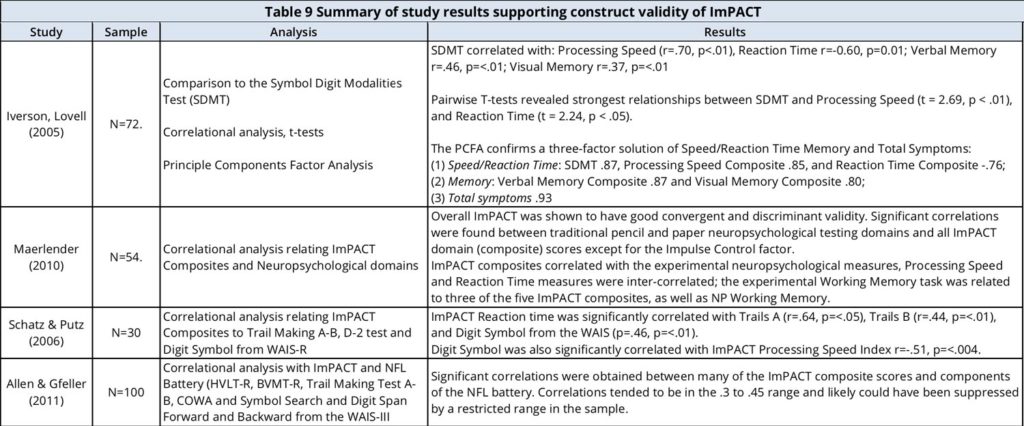Construct and concurrent validity of ImPACT and ImPACT Version 4
One of the first studies to look at the construct validity of ImPACT was completed by Iverson, Lovell and Collins (2005) who administered ImPACT to the Symbol Digits Modalities Test (Smith, 1982). A sample of 72 athletes randomly selected from a larger sample were administered both scales. All athletes had successfully completed an ImPACT baseline test prior to participation and at a later time were determined to have suffered a concussion by a physician or an ATC. Correlational analysis, t-tests and Principle Components Factor Analysis were completed. The SDMT was found to correlate .70 with Processing Speed and -.60 with Reaction Time. Pairwise T-tests revealed strongest relationships were between SDMT and Processing Speed and Reaction Time versus Verbal, or Visual Memory or Total Symptoms. The PCFA confirmed a three-factor solution of Speed/Reaction Time Memory and Total Symptoms as the solution best fitting the data.
Schatz and Putz (2006) studied 30 college student volunteers who were administered the Trail Making Test A &B (TMT) and the Digit Symbol subtest of the Wechsler Adult Intelligence Scale–Revised (WAIS–R). These researchers found that Reaction time was significantly correlated with Trails A-B (.61, .44 respectively) and Digit Symbol from the WAIS (.46). Digit Symbol was also significantly correlated with ImPACT Processing Speed Index -.51
In the most extensive independent study published to date, Maerlender (2010) examined the correlations of ImPACT with a traditional comprehensive test battery. These authors’ test battery was comprised of tests of verbal (California Verbal Learning Test [CVLT]) and visual memory (Brief Visuospatial Test-Revised [BVMT-R™]); cognitive speed (Trail Making Tests- A and B, Verbal Fluency, Delis-Kaplan Executive Function System [DKEFS] Color Word Memory); reaction time (Conners Continuous Performance Test [CPT]) and working memory (Paced Auditory Serial Addition Test [PASAT]). They concluded that “the present study demonstrates that cognitive domains represented by ImPACT have good construct validity with standard neuropsychological tests that are sensitive to cognitive functions associated with mild TBI”. They highlighted that ImPACT is best used as a screening tool along with other neuropsychological tests.
Allen and Gfeller (2011) compared ImPACT to a standard “paper and pencil” test battery. In this study, 100 neurologically intact college students completed ImPACT and a more traditional test battery that was previously used throughout the National Football League (NFL). Tests were administered in counter balanced order. A factor analysis was completed and correlations between the two batteries were presented. The authors found significant overlap between the batteries’ assessed constructs, but noted slightly different factor structures for them.

For ages 60-80, to determine whether ImPACT Version 4 correlates significantly with a widely utilized and previously validated instrument of Memory and Motor Speed, select subtests of the HVLT, BVMT-R, SDMT, and ImPACT were administered within the same session. The sample was composed of 71 individuals between the ages of 60 and 80 (mean age of 67.27 years, S.D. 4.92 years) with 63.4% females and 36.6% males. All measures were administered by Neuropsychologists who were trained in test administration as part of the study to collect data for the normative dataset described in section 2.

ImPACT Verbal and Visual Memory Composite scores correlate with both the HVLT and BVMT-R, as well as the SDMT Memory Sub-scales (significant at P<.001) which represent measures of verbal and visual memory. ImPACT Motor Speed and Reaction Time Composite Score both correlate with the SDMT Total Correct Subscales, which represents a measure of psychomotor coding speed. These correlations provide validity support to the claim that ImPACT is a measure of Verbal and Visual Memory and psychomotor speed.
Not the solution you are looking for?
Please check other articles or open a support ticket.